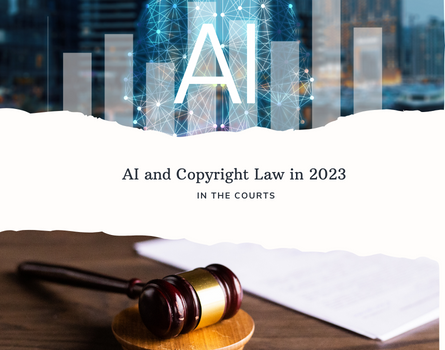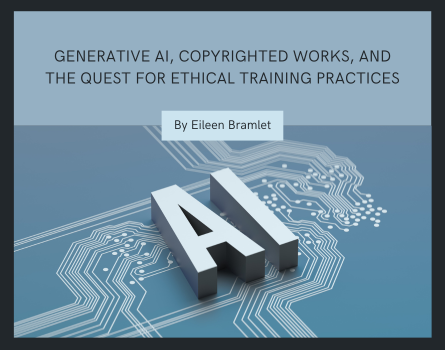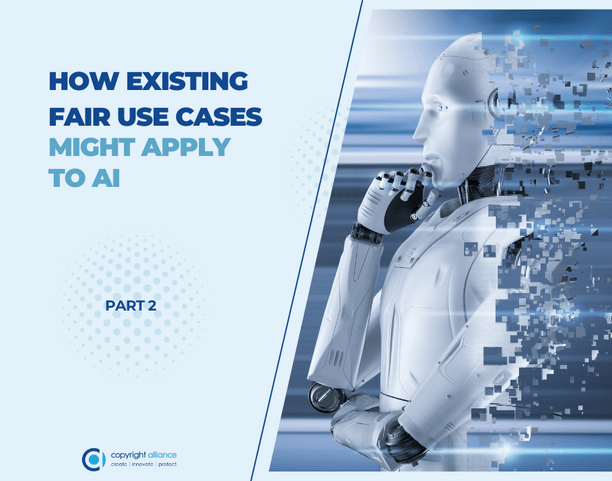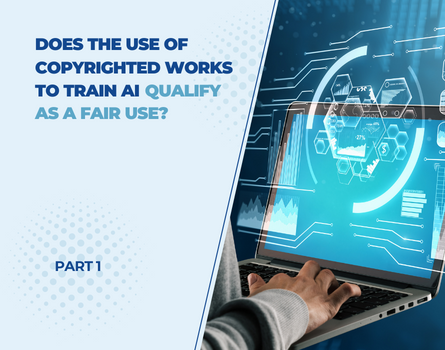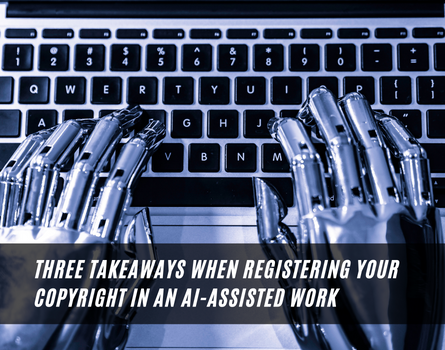2023 was an extremely busy year for artificial intelligence (AI). That was especially true for copyright issues related to AI, which sparked several Congressional hearings, a study by the U.S. Copyright Office, and other government engagements studying the intersection of AI and copyright. In part one of this blog series we highlight the most important AI copyright-related activities taking place in Congress, the federal government, and the U.S. Copyright Office which occupied our attention in 2023. In part two, we’ll explore the various court cases involving copyright and AI.
U.S. Copyright Office AI Activities
Throughout the year the Copyright Office was extremely busy with a host of AI and copyright related events and activities including issuing an official guidance on registering works with AI-generated elements, publishing opinion letters rejecting certain registration applications of works containing AI-generated elements, and hosting listening sessions on industry-specific AI and copyright law issues.
Policy Statement on Registering AI-Generated Output and Application of the Guidance to Applications:In March, the Copyright Office kicked off its AI activities by issuing a statement of policy clarifying its practices for examining and registering works that contain material generated by AI technology, effective immediately. The Office explained that human authorship is required for copyright protection, that it will refuse to register works solely generated by AI, and that any material which is not the product of human authorship must be disclaimed on a registration application. For more information and discussion about the Office’s registration guidance, check out our blog post.
Throughout the year, the Copyright Office applied this guidance to reject various applications for works containing AI-generated elements. Several of these decisions were made public by the Copyright Office. These include:
Kashtanova: The Copyright Office began proceedings to investigate the copyright registration for a graphic novel, Zarya of the Dawn, after the agency became aware of news reports indicating that the applicant, Kristina Kashtanova, created the work using the AI tool, Midjourney. In February, the Office sent a letter in response to Kashtanova’s letter defending copyrightability of the work, explaining that the Office would be reissuing a certificate of registration that would not extend to any AI-generated material in the graphic novel. The Office stated that because the AI “generat[ed] the images in an unpredictable way” and the AI tool was “not controlled or guided” by Kashtanova, the images did not have sufficient human authorship.
Allen: In September, the Copyright Office rejected a second request for reconsideration made by an artist, Jason Allen, refusing to register a 2-D image titled Théâtre D’opéra Spatial because the work contained more than a de minimis amount of AI-generated work which Allen refused to disclaim on the registration application. The Office rejected Allen’s three claims to human authorship, stating: (1) the image, as generated by Midjourney, lacked human authorship because Allen’s sole contribution was to input text prompts into Midjourney; (2) the Office could not decide whether Allen contributed any human authorship to the image via adjustments made to the image via Adobe products because there was a lack of information; and (3) the use of Gigapixel AI to scale the image did not introduce new, original elements into the image and that these acts did not amount to authorship.
Sahni: In December, the Copyright Office published its review board opinion, rejecting the registration application filed for a 2-D image titled Suryast. The application was filed by Ankit Sahni, who listed himself and his AI machine, RAGHAV Artificial Intelligence Painting App, as co-authors of the image. Sahni has filed registration applications for the same image in India listing the AI as a co-author. The application was initially accepted in India but is subject to a withdrawal and review process. The Office concluded that the image was not a product of human authorship because the expressive elements of the pictorial authorship were not provided by Sahni. The Office found that Sahni’s three inputs of providing the base input image, a style image, and the values to have the AI generate the style did not control how the expressive elements appeared in the output and did not amount to copyrightable contributions.
Listening Sessions: To begin the process of learning about the impact of AI on copyright, the Copyright Office hosted a series of AI listening sessions on generative AI and copyright in the spring so that they could hear from stakeholders and other interested parties on various issues related to the topic. The Office held four sessions, with each session focusing on the impact of AI on a different type of work. The first session covered literary works, the second session addressed works of visual arts, the third covered audiovisual works, and the final session covered music and sound recordings. Across the sessions, speakers addressed how AI tools are used by creators, the harms regarding AI ingestion of copyrighted works, AI licensing markets, the Office’s AI registration guidance, the effects of AI on creators, and many other issues. The information gathered during the sessions was intended to inform the Copyright Office’s approach to a formal study later in the year (see below).
AI Webinars: Following the listening sessions, the Copyright Office continued its examination into AI issues by hosting two webinars. The first webinar, titled Guidance for Works Containing AI-Generated Content, consisted of the Office providing examples applying its AI registration guidelines to different types of works and explained whether, when, and how AI-generated elements should be disclaimed in the electronic copyright application system. In the second webinar, titled International Copyright Issues and Artificial Intelligence, presenters discussed how other countries are approaching copyright questions related to AI such as AI authorship, AI training, exceptions and limitations, and infringement. Panelists also provided an overview of legislative developments in other regions and highlighted possible areas of convergence and divergence involving generative AI.
AI and Copyright Study: All these activities culminated with the Office publishing a notice of inquiry and request for comments in the Federal Register for its Artificial Intelligence and Copyright study at the end of the summer. The Office solicited comments to help it collect factual information and policy views relevant to copyright law and policy and to inform the agency on issues involving the use of copyrighted works to train AI models, the appropriate levels of transparency and disclosure with respect to the use of copyrighted works, and the legal status of AI-generated outputs. By the time the dust had settled at the October 30th comment deadline, the Office had received around 10,000 initial comments, and then over 600 additional reply comments at the December deadline. All these comments can all be found on the NOI docket webpage. The Copyright Alliance submitted comments and reply comments highlighting, among many other things, concerns surrounding infringement related to the unauthorized use of copyrighted works for training. Other commentors included thousands of individual creators, several Copyright Alliance members, and the Federal Trade Commission, which filed comments noting that the agency has an interest in copyright-related issues to the extent that AI can harm a creator’s ability to compete in markets, as well as other issues such as misleading information about the authorship of AI-generated works.
Biden Administration Activities
While the Copyright Office was swept up in a whirlwind of AI and copyright activities, the Biden Administration was also busily examining these issues as it began to be alerted to the ways generative AI technologies were harming creators and copyright owners. Here are a few highlights of AI and copyright-related activities from the Biden Administration over the past year as it looks at ways of addressing AI and copyright law issues under the AI Executive Order.
NTIA Solicits Comments on AI Accountability: In the beginning of the year, the National Telecommunications and Information Administration (NTIA) published a request for comments regarding self-regulatory, regulatory, and other measures and policies that are designed to provide assurance that AI systems are legal, effective, ethical, safe, and otherwise trustworthy. The Copyright Alliance filed comments discussing the need for increased accountability and transparency in the context of ingestion of copyrighted works by AI systems, and how respecting copyrighted works results in trustworthy AI systems.
NAIAC Hosts Briefing Session on AI and Copyright Issues: In September, the Biden Administration’s National Artificial Intelligence Advisory Committee (NAIAC) hosted a briefing session on IP and Copyright, featuring a presentation by Aaron Cooper, BSA | The Software Alliance; Keith Kupferschmid, CEO, Copyright Alliance; and Catherine Stihler, Creative Commons. Through this session, the NAIAC sought to better understand the changing landscape of AI and the challenges of adapting existing copyright regulations or possibly introducing new ones. The panelists addressed copyright concerns pertaining to music, film, and written works, and highlighted the potential pitfalls of using unlicensed data for training generative AI. Emphasis was also placed on the importance of reliable, diverse training data for AI and the fact that the U.S. Copyright Office was also studying the complex implications on copyright law by generative AI technologies.
FTC Hosts Roundtable on AI and Creative Economy Issues: A month later, the Federal Trade Commission (FTC) held an excellent roundtable titled Creative Economy and Generative AI during which a variety of professionals and representatives from a broad range of creative disciplines discussed how AI tools are reshaping their respective lines of work and how they’re responding to these changes. This roundtable by the FTC illuminated the specific copyright and other concerns of the creative community, and the ways generative AI was harming creators and copyright owners’ markets and ability to engage in further creative endeavors. In her opening statement, FTC Chair, Lina Khan, acknowledged the unique challenges that AI-generated content poses to creative industries and recognized the importance of shaping regulatory policies in this rapidly evolving landscape. FTC Commissioner, Alvaro Bedoya, provided closing remarks, expressing profound concerns about the impact of generative AI on creators and the importance of preserving the uniqueness of human creativity. He emphasized that while AI may have expansive capabilities, it should not be expected to replace the genius of human creativity. He argued that the foundation of genius lies in people and that AI cannot extinguish human creativity. He emphasized the need to consider new legal frameworks to address such developments, drawing parallels to the creation of the Federal Trade Commission in 1914 to address innovations in unfair competition. In the end of 2023, the FTC published a report titled Generative Artificial Intelligence and the Creative Economy Staff Report: Perspectives and Takeaways, summarizing the information provided to the agency during the roundtable. In its report the FTC noted that “. . . targeted enforcement under the FTC’s existing authority in AI-related markets can help to foster fair competition and protect people in creative industries and beyond from unfair or deceptive practices.” The report also highlighted potential areas of further inquiry, including the effects or lack thereof of opt-out regimes by AI companies, the status of “unlearning” research, and the long-term effects of practices of AI companies from the uncompensated and unauthorized use of creators’ works.
President Biden Issues AI Executive Order: In October, President Biden signed the Executive Order on the Safe, Secure, and Trustworthy Development and Use of Artificial Intelligence (EO), which spans a number of AI-related topics. Section 5.2 of the EO, titled Promoting Innovation, addresses copyright in paragraph (c)(iii). It says: “within 270 days of the date of this order or 180 days after the United States Copyright Office of the Library of Congress publishes its forthcoming AI study that will address copyright issues raised by AI, whichever comes later, consult with the Director of the United States Copyright Office and issue recommendations to the President on potential executive actions relating to copyright and AI. The order provides that the recommendations shall address any copyright and related issues discussed in the United States Copyright Office’s study, including the scope of protection for works produced using AI and the treatment of copyrighted works in AI training.” The EO also directs the Secretary of Homeland Security, in consultation with the Attorney General, to develop a training, analysis, and evaluation program to mitigate AI-related IP risks and specifies the details of the program. A summary of the EO can be found in the White House’s Fact Sheet. It is encouraging to see that the Biden Administration is keyed into the fact that generative AI has affected the creative community, and it will be interesting to see the specific recommendations made once the U.S. Copyright Office issues its studies on AI and copyright law issues.
Congressional Activities
Members of Congress and their staff also spent a good portion of 2023 learning about and addressing the AI issues that affect and harm creative professionals. Although there were numerous Congressional hearings and bills introduced on AI issues as they affect the creative community, we highlight here a few hearings in which AI and copyright law issues were the specific focus of the hearing. Some of these hearings featured a representative mix of witnesses and speakers from the creative community who are affected by AI technologies. However, some hearings unfortunately did not provide the most affected members of the creative community with an opportunity to provide views. We hope this will change for future Congressional hearings and meetings in which AI and copyright concerns are up for discussion, and that a diverse set of creative voices can provide feedback on AI issues to our nation’s lawmakers.
House Judiciary IP Subcommittee: In May, the House Judiciary Subcommittee on Courts, Intellectual Property, and the Internet held a hearing titled Artificial Intelligence and Intellectual Property: Part I—Interoperability of AI and Copyright Law. Witnesses included Sy Damle, Latham & Watkins LLP; Chris Callison-Burch, Associate Professor of Computer and Information Science, University of Pennsylvania; Ashley Irwin, President, Society of Composers and Lyricists; Dan Navarro, Grammy-nominated songwriter, singer, recording artist, and voice actor; and Jeffrey Sedlik, President & CEO, PLUS Coalition. Lawmakers and witnesses discussed a myriad of pressing topics at the intersection of AI and copyright law, including the use of copyright-protected works in the training of generative AI models, copyright protection of works that were produced with the assistance of generative AI, and the economic impact of generative AI on creators and creative industries. Speaking about ingestion, Damle and Callison-Burch both incorrectly insisted that training AI systems categorically qualifies as a fair use. In response, former General Counsel for the U.S. Copyright Office, Jon Baumgarten, penned a letter to Members of the Subcommittee, warning them against these false categorical statements. Meanwhile, the creatives and artists on the panel—including Irwin, Navarro, and Sedlik—raised concern that generative AI systems are being trained using troves of rights holders’ works without their consent, credit, or compensation. Another issue that witnesses and members grappled with was whether the output of AI systems could be eligible for copyright protection. Finally, there seemed to be a consensus among panelists and members on the Subcommittee that transparency will be a key component to the responsible implementation of AI into our society.
Senate Judiciary IP Subcommittee: In July, the Senate Judiciary Committee’s IP Subcommittee held a hearing titled Artificial Intelligence and Intellectual Property—Part II: Copyright. Witnesses included Jeffrey Harleston, General Counsel and EVP of Universal Music Group; Karla Ortiz, Concept Artist, Illustrator, and Fine Artist; Matthew Sag, Professor of Law, Emory University School of Law; Dana Rao, EVP, General Counsel and Chief Trust Officer, Adobe; and Ben Brooks, Head of Public Policy, Stability AI. The Senators and panelists discussed various topics including the ability of artists to opt-out of AI training and the feasibility and technical effects of respecting those requests on AI development; the role and desirability of licensing copyrighted works for AI ingestion; voluntary, standardized, or other international frameworks around transparency in all stages of AI development and use; and the application of fair use law in the context of AI training. During the hearing, Ortiz highlighted that whether copyrighted works are licensed for AI use should be the artist’s choice, as is the status quo under copyright law—but that this fundamental right and ability to make this choice had been stripped from artists as copyrighted works are being used for AI training without any credit, compensation, or consent. Rao, citing to the development process of Adobe’s Firefly platform, highlighted how AI systems trained on limited datasets that include licensed materials as opposed to indiscriminate scraping and ingestion of works without authorization or licensing.
Senator Schumer AI Insight Forum on Copyright: In November, Senator Chuck Schumer (D-NY) held the seventh closed-door AI meeting in the Insight Forum series. The meeting focused on transparency, explainability, and intellectual property and copyright issues. Speakers included Ali Farhadi, Allen Institute for AI; Ben Brooks, Stability AI; Curtis LeGyt, National Association of Broadcasters (NAB); Danielle Coffey, News/Media Alliance; Jon Schleuss, News Guild; Vanessa Holtgrewe, IATSE; Duncan Crabtree-Ireland, SAG-AFTRA; Ben Sheffner, Motion Picture Association (MPA); Dennis Kooker; Sony Music Entertainment; Rick Beato, musician; and Ziad Sultan, Spotify. The speakers generally agreed that no legislative changes were necessary at this time because the issues were being played out in the courts. Speaker statements are available on the Senator’s webpage. Though some members of the creative industries or their collective representatives were present for the hearing, it was disheartening to see that individual creators and authors—critically from the visual arts and literary fields—were affirmatively not invited to speak and share their views at the meeting. These creators are the most immediately affected and harmed by generative AI technologies, as evidenced by the slew of the AI-copyright related lawsuits brought in the past year. The absence of these creators in this meeting casts a pall on any impact that this meeting otherwise would have had.
Senate Judiciary Subcommittee on Privacy, Technology, and Law: On May 16, the Senate Judiciary Subcommittee on Privacy, Technology, and Law held a hearing titled Oversight of A.I.: Rules for Artificial Intelligence. Witnesses included Samuel Altman, CEO, OpenAI; Christina Montgomery, Chief Privacy & Trust Officer, IBM; and Gary Marcus, Professor Emeritus, New York University. The hearing encompassed a wide range of concerns related to AI, including privacy, job disruption, copyright, licensing of AI products, and the impact of Section 230. The focus was on identifying the regulatory measures needed to address these concerns and ensure the responsible development and deployment of AI technologies. Senators Marsha Blackburn (R-TN) and Amy Klobuchar (D-MN) emphasized the importance of compensating creators and copyright owners for the use of their works to train AI. Senator Blackburn specifically suggested SoundExchange’s model. Altman informed members that OpenAI is actively developing a copyright system designed to provide compensation to artists whose work has been utilized in the creation of new content. He also said that content creators should have a say in how their voices, likenesses, and copyrighted content are used to train AI models, stating that “creators should deserve control over how their creations are used” and that OpenAI is working with artists and creators on licensing. However, again, regrettably, there was no one from the creative community invited to this panel to provide even a small window into the views of those most affected by generative AI technologies.
Looking Forward to 2024
The federal government, whether in Congress, the executive offices, or at the U.S. Copyright Office, was extremely engaged on AI and copyright law issues in 2023. In 2024, we can expect the Copyright Office’s reports from its AI and copyright law study in addition to recommendations the Biden Administration will set forth based on the Copyright Office’s findings. We can also expect Congress to remain engaged in copyright law and AI issues, with perhaps several more hearings, as other AI developments, particularly in the courts, continue to unfold.
Stay tuned for Part 2 of this blog series, which will highlight some of the major AI and copyright law cases from 2023. For more information on AI and copyright issues in the meantime, visit our AI and Copyright webpage and sign up for our AI Alert for the latest news on this subject.
If you aren’t already a member of the Copyright Alliance, you can join today by completing our Individual Creator Members membership form! Members gain access to monthly newsletters, educational webinars, and so much more — all for free!



